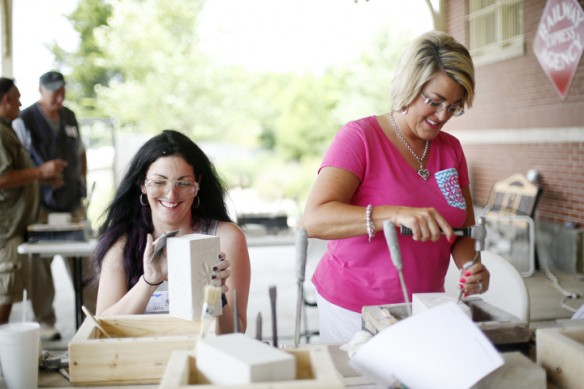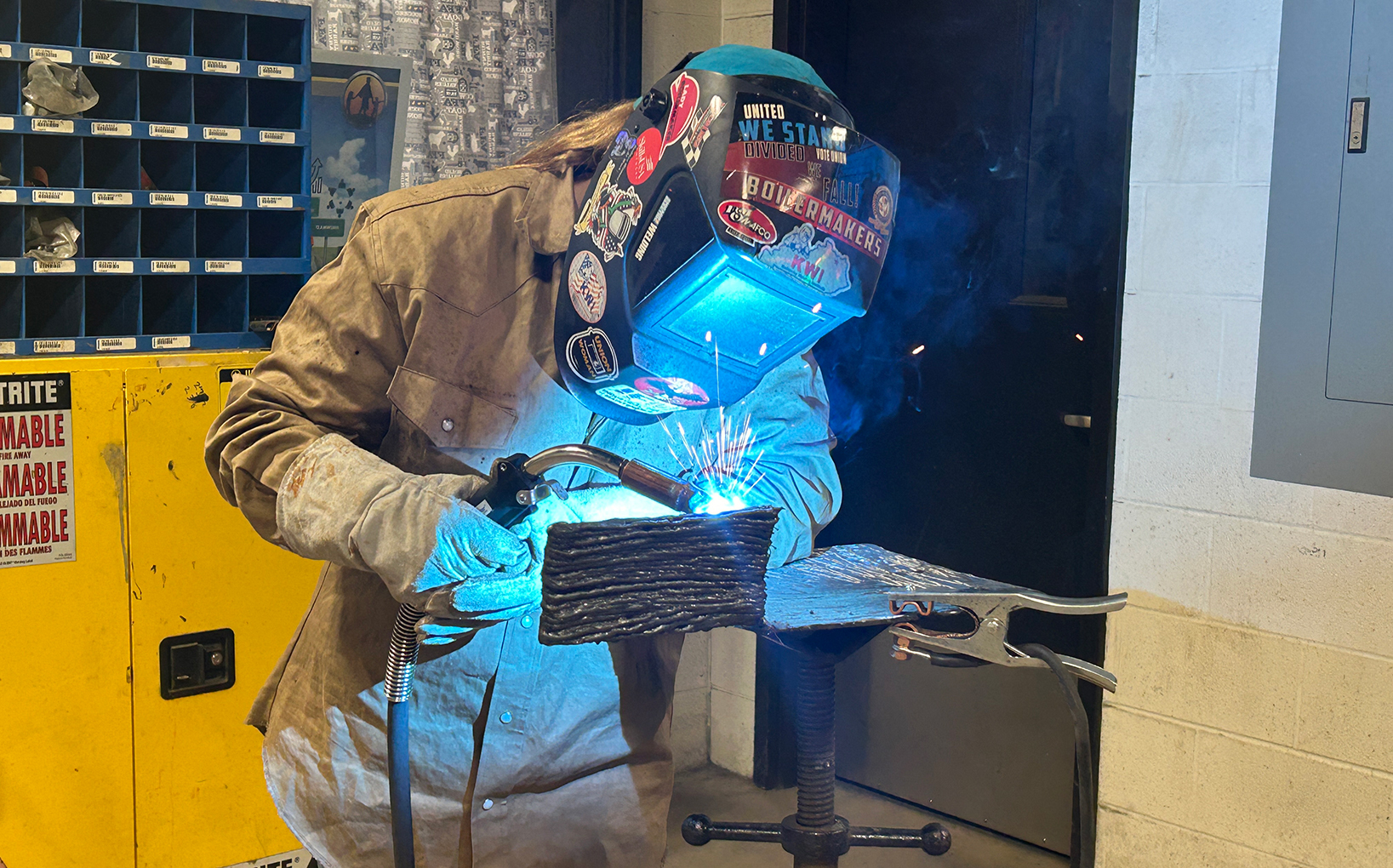
South Laurel Middle School (Laurel County) teachers Heather Ponder and JoAnna Sizemore create personal totems during the Berea Festival of Learnshops. Both teach in the arts and frequently team teach.
Photo by Amy Wallot, July 13, 2015
By Brenna R. Kelly
Brenna.kelly@education.ky.gov
As she tapped a chisel into a block of limestone, Jennifer Gabbert was already thinking about how she could recreate the carving activity for her kindergarten students.
“I’m thinking about little foam blocks and letting them use stylus sticks and they can push symbols in,” said Gabbert, an art teacher at the Early Learning Village (Franklin County).
Gabbert was one of several teachers learning to carve totem poles out of limestone as part of the Berea Festival of Learnshops. The Festival, now in its fifth year, allows teachers and the public a chance to learn from working artists in the arts-centered Madison County town.
“They’ve got something new every year,” said Gabbert who has attend for five years. “It’s great for new ideas to take back to the classroom and for getting to work with experts.”
Most of the 128 teachers who attended this year’s Learnshops spent part of their time learning to improve their school’s Program Reviews, getting an update on the new National Core Arts Standards and learning about resources to help integrate arts into the classroom.
But the most important part of the professional learning is getting the chance to do art, said Judy Sizemore, arts consultant and co-organizer of the event.
The 16-day event, sponsored by Berea Tourism, features more than 100 workshops such as painting with watercolors, puppetry, storytelling, building a musical instrument, making corn shuck art, integrating movement into the classroom and basket weaving. Most of the workshops geared toward educators were held July 13-14 and July 20-21.
“To a large extent they choose ones that they want to do for themselves, which I think is perfectly valid,” Sizemore said. “Part of what we want to do is to validate the joy of creation and remind them that that’s an important thing to take back to their students.”
In addition to the workshops, teachers also receive a LiveBinder, an online repository of resources to help them share what they learned with their students. It includes examples from teachers who have attended previous Learnshops and all of the information from the Program Review and standards sessions as well as resources from more than 40 different arts instructors.
Finding quality professional development for arts and humanities is often hard, said JoAnna Sizemore, a music teacher at South Laurel Elementary who is not related to Judy Sizemore.
“All these years of having to go to reading workshops and math PD, and I was like, where is ours?” said Sizemore, was carving a totem with Gabbert.
But arts professional development opportunities have increased since Program Reviews became part of the state’s accountability system, she said.
“It’s all about the Program Review now,” she said.
Program Reviews, which cover arts and humanities, writing and practical living, were mandated by Senate Bill 1 (2009) as a way to assess school’s programs in areas that are difficult to measure with a test.
The reviews, which are self-scored by schools, are designed to improve teaching and learning, allow students access to the skills they need to be productive citizens, demonstrate understanding beyond paper-and-pencil tests and ensure school-wide integration of the program skills across all content areas.
Earlier this year, a Kentucky Department of Education audit of Program Reviews showed that many of the schools audited had over scored their programs.
“They were seeing that the brunt of the responsibility for Program Reviews was falling on one person or a small group, and it should be across all content areas,” Sizemore told the teachers during a workshop.
Learning more about how to write a Program Reviews was the main reason Martina Lutz, band teacher for Johnson County Schools, attended the Learnshops.
“I realized I do all of this stuff when I teach but I don’t know how to present it in such a way that proves that I am teaching it correctly,” Lutz said. “The language of the Program Review can be really difficult.”
Teachers could also attend sessions on formative assessments, arts standards and one-on-one help for Program Reviews. They also learned about arts resources from KET and the Kentucky Arts Council.
“There is help available but most people don’t know where it is or how to get it,” Judy Sizemore said.
Andrea Murray, principal of Rodburn Elementary (Rowan County), attended a session with Sarah Evans, director of the Southeast/South Central Arts and Humanities Collaborative, to find out more information about the new National Core Arts Standards, which when adopted will become part of the Kentucky Core Academic Standards. The standards are going through the regulatory process now, and are are scheduled to be implemented during the 2016-17 school year.
Evans showed her the National Core Arts website which allows teachers to build their own customized handbook based on their grade level and discipline.
“My arts people are going to be so happy when I go back and show them this,” said Murray, a former art teacher.
Murray said she attended the Learnshops because she wanted be able to give her arts teachers more support.
“I scheduled my vacation around this,” she said. “I want to make sure that I’m busting my butt, getting out there and getting the right information and finding ways for us to get the best (Program Review) scores.”
Anne Hall, a librarian at Shearer Elementary (Clark County), also found the Program Review session helpful because she could learn from the arts consultants about how they were supposed to be done.
“Sometimes what the state expects from Program Review and what principals expect are two different things,” Hall said. “Program Reviews are not just about related arts people getting the evidence; it’s about everybody getting the evidence.”
Hall’s school came up with a solution – a folder on a common drive where they saved lesson plans, pictures and other items for Program Reviews in the same place.
“That would be my best advice for any school,” she said. “That gives everybody accountability and everybody buy in.”
While many teachers came for the Program Review and standards information, it was the workshops that got them energized.
“You have to put it between your knees and grip,” Instructor Donna Lamb called out as she taught teachers how to make a cantar, a stringed instrument made from a soup can and a piece of wood.
The teachers held the can between their knees and hammered into the side of the can in order to affix it to the neck of the instrument.
“My kids will go nuts over this, “said Laura Wilson, a music teacher at Strode Station Elementary (Clark County). “I’ll use it in class and compare it to a dulcimer and we can talk about other string instruments.”
Wilson also planned to use the homemade instrument as an example of recycling and turning trash into something useable.
“This could be a fun combined music and art project if you had the right materials,” she said. “The art teacher and I have been talking about doing a project where the students make their own instruments.”
Igniting that spark of creativity is what the Learnshops are all about, Sizemore said.
“Go out and remember why you love to do this, why you started to do it begin with,” she said, “And think about what is it that you really want to share with your kids. You want them to have that same sense of challenge and joy in creating something.”
MORE INFO …
Judy Sizemore circuit@prtcnet.org
Sarah Evans sarah.evans@sesccoop.org



Leave A Comment